By Paul R. Sanberg
Editor's Note: The following remarks were written by Paul R. Sanberg for his John P. McGovern Science and Society Award lecture, which he presented at the Sigma Xi 2016 Annual Meeting in Atlanta, Georgia. Sanberg is the senior vice president for Research, Innovation, & Economic Development and a distinguished university professor at the University of South Florida. He is also the executive director of USF’s Center of Excellence for Aging and Brain Repair and the president of the National Academy of Inventors. A main message of his lecture was that researchers have a meaningful role to play in society by sharing the benefits of their discoveries with other people.
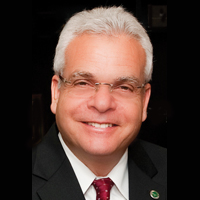 Good evening everyone! Thank you very much for that warm welcome and thank you for this tremendous honor.
Good evening everyone! Thank you very much for that warm welcome and thank you for this tremendous honor.
It is with deep gratitude and humility that I accept the John P. McGovern Award, and I thank the members of the awards committee, the board of Sigma XI and all its members for this very special recognition.
There is no more gratifying moment in a career than when your colleagues and peers single out your work, and even more so when the award bears the name of a transformative figure in American medical research and healthcare philanthropy.
The son of a surgeon who graduated from Duke University School of Medicine, John P. McGovern taught at George Washington University Medical School and Tulane Medical School. He established the McGovern Allergy Clinic in Houston and created the Texas Allergy Research Foundation. He held 17 professorships, received 29 honorary doctorates, and authored over 250 professional publications and books.
His expertise in asthma and immunology was groundbreaking, and his exemplary leadership record included serving 15 professional medical societies.
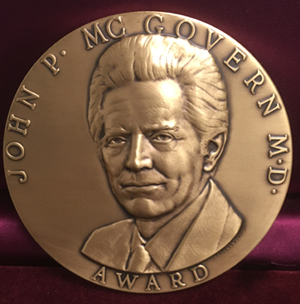 He was known far and wide as a “medical humanist.” Despite his many years immersed in medicine, he later would recount that the most important influence on his life had not been his father the surgeon or the many other great physicians he trained and worked for, but his grandmother who would feed the poor during the Great Depression.
He was known far and wide as a “medical humanist.” Despite his many years immersed in medicine, he later would recount that the most important influence on his life had not been his father the surgeon or the many other great physicians he trained and worked for, but his grandmother who would feed the poor during the Great Depression.
He once told the Houston Chronicle: "I learned from watching my grandmother that giving and receiving is the same thing. I could see in her eyes that it made her feel good. … I think everybody's got an empty spot inside, and I call it the God-sized hole that we have to fill. And you can't do that with Caesar's world stuff — money, property, prestige. That doesn't fill that hole. Love does ... Love, in the sense of deep caring."
After his death in 2007 at the age of 85, his friends would say that Dr. McGovern’s motivation to make new discoveries in medical science, was never about prestige or wealth, but to honor and improve the human condition.
I can think of no better thing to be said about someone who pursues a path in the sciences. This award takes on very special meaning for me because it reminds us all of the larger calling to serve humankind that is embedded in scientific discovery, invention and innovation.
The urge to explore and discover is not always about the unknown.
Sometimes it is about discovering what is inside of us. … Often, it is about embracing our own truths, and fully realizing that what means most is not the awards or recognition we achieve for ourselves, but in how our talents and abilities can serve others.
***
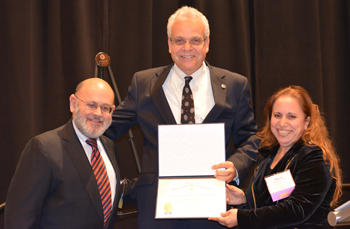 Scientists are born curious—at least I think I was, and I bet each of you has similar memories of being a child and exploring some of the same basic ideas that now are central to your research portfolio.
Scientists are born curious—at least I think I was, and I bet each of you has similar memories of being a child and exploring some of the same basic ideas that now are central to your research portfolio.
You know that commercial with the “Most Interesting Man in the World,” whose tag line is: “Stay Thirsty, my friends”.
I think a better line for people in the scientific professions is “Stay Curious, my friends”
because it’s that curiosity that will lead to exploration, discovery, and innovation.
You and I are fortunate to be alive in a time of such remarkable technological change, where global interconnectivity has transformed not only how we communicate and can collaborate, but allows discoveries to spread at the speed it takes to hit the “send” button.
But sometimes, what produces the most meaningful science is what happens closest to home. And today I am going to talk a little bit about the journey: where it starts, where it can lead, and why, in the most desperate moments, you’ll find your path forward.
This is my personal story, but I have found the experience is universal.
This is my colleague at the University of South Florida, Merry Lynn Morris. Some of you might have seen her work in inventing a dance chair featured on Katie Couric’s show and in Reader’s Digest. Merry Lynn has revolutionized mobility for those with disabilities by working with engineering students to produce a wheelchair that moves more fluidly through redesigned engineering and wireless technology.
Merry Lynn is actually a dance professor at USF, but she was motivated to develop this technology because, as a little girl, her father had been paralyzed in a car accident.
She just wanted to be able to dance with him, and his bulky wheel chair wouldn’t allow it. Decades later, she would create the dance chair by working with our engineering students and incorporating it into a mixed-abilities dance group she leads.
And this is my friend and colleague David Vesely at the USF Morsani College of Medicine. David has spent his career conducting breakthrough research on how cardiac hormones might control cancer. He was drawn to this work after his wife, Clo, died of breast cancer, leaving him with five children.
David’s research had already shown these hormones prevented heart cells from growing too big, and in the aftermath of his wife’s death, he wondered what they could do to prevent tumor growth.
In his lab, David has killed the deadliest forms of cancer with these hormones, including pancreatic, breast, lung, colon, prostate, and kidney cancers. In one experiment, his fourth son was working with him in the lab and witnessed the cancer cell destruction with his very own eyes. Can you imagine a more personal—yet scientifically triumphant—moment?
Through this family’s tragedy, clinical trials and, hopefully, new drugs will emerge. Exploring. Discovering. Moving forward. Sometimes that’s all you know how to do.
***
My story begins in Hialeah, Florida, and looking back on my earliest memories of being in school, I can appreciate those moments that steered me to a career as a research scientist, inventor, and entrepreneur.
One of my early memories is being six or seven years old—right in the middle of the Space Race—and being asked to come on to a local Miami television show where they would give certain children math questions to solve. Looking back at that experience, it was incredibly encouraging.
My family later moved to California. My mother and father worked hard to achieve the American dream for our large family, and I was the first in our family to earn a bachelor’s degree.
I was a very typical teenager of the times: I was into music, loved sports and was interested in flying. But science had a constant tug on my attention.
In high school I had a wonderful biology teacher, Mrs. Haddick, who introduced me to a subject that fascinated me and was the start of what I’ve worked on my entire life. Years later, when I was a professor at the University of Cincinnati, to my surprise, Mrs. Haddick came to hear me speak at a conference for biology teachers. Afterwards, she let me know that she was proud to see the accomplishments of one of her students. Her belief and encouragement made an impact on me as a teenager, and meant a lot to me as an adult.
At York University, where I did my undergraduate degree, one of the jobs I took to pay my tuition was working in a physiological psychology lab where the researcher was running lab tests on rats. I was enthralled.
By my third year, I was conducting my own research projects and publishing my work in very well-known journals. I greatly admired the professor whose lab I worked in, but I was surprised how that innate curiosity of a young man elicited the opposite reaction I’d expected.
My new ideas were met with skepticism and derision. My discoveries were questioned, and it rocked my confidence.
But you know what’s more powerful than criticism? Curiosity.
I learned at an early age—and the hard way—that scientific research requires patience and perseverance.
Looking back now, I realize how much those years shaped my outlook in wanting to build a supportive and encouraging community for innovators and inventors—to make those who challenge conventional thinking be appreciated for their talents and their drive to discover and invent.
And then my world was rocked by an experience so personal, yet so universal, it put my whole career into new perspective.
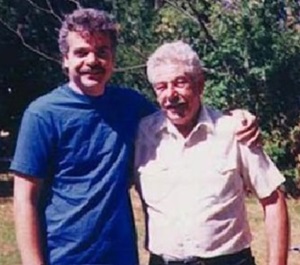 My father, Bernard Sanberg, suffered a severe stroke. At the time, I was already deep in neurological research, looking at Parkinson’s disease and how to treat the effects of this devastating condition.
My father, Bernard Sanberg, suffered a severe stroke. At the time, I was already deep in neurological research, looking at Parkinson’s disease and how to treat the effects of this devastating condition.
But even with all that expertise, I cannot tell you how powerless I felt in those seemingly endless hours and days by my dad’s bedside when the answer to every question was: “There’s not much we can do.”
That was 1994, and my father was living in Houston when he suffered the stroke. The University of Texas Health Sciences Center, where he was treated, is an excellent hospital. But the treatment that was provided for him was pretty rudimentary—it was what the doctors had learned in medical school, and it hadn’t evolved much since they learned it. Every day I’d ask them: “Why don’t we try something new?”
But there wasn’t anything new to try. How could that be? There are about 750 thousand people a year who suffer strokes in the United States, and it’s the leading cause of disability nationwide.
There were millions of people standing by … with not much more than a clot-busting drug and hope that rehabilitation will work.
I couldn’t help my Dad much sitting by his bedside, but I thought that if I could get back into my lab, I could find a better way.
That’s when I refocused my work and began researching novel stem cells as a promising treatment for stroke.
I took two approaches: One looking at the direct injection of stem cells into the brain and, also, at intravenous treatments. Incredibly, when the human brain has dying cells, it produces a protein that signals the body to send new stem cells—which can become brain cells—through the blood–brain barrier.
Your body is actually doing it all the time. But in a stroke patient, the blood–brain barrier opens, but then it can close over time. We have a limited window after an acute stroke to take advantage of the opportunity to repair the brain.
We looked at stem cells from bone marrow and then, later, umbilical cord blood, as well as adult stem cell sources, like mesenchymal stem cells, epidermal stem cells, and cells from other organs.
By 1998, we were able to even use a tumor-derived cell for direct injections into the brain. The results were very encouraging. By 2000, we were testing cultured neural stem cells in stroke patients, and we were seeing good results.
But there is an overwhelming challenge on getting these cells to the damaged area of the brain. Direct injections require expensive neurosurgery and, there are so many stroke patients who could use this therapy, that there simply wouldn’t be enough practicing neurosurgeons to perform the procedure, if it were available to all sufferers.
Add in all of those with Parkinson’s, Alzheimer’s, or other neurodegenerative diseases who also might benefit from this therapy, and you’d see that the only way to make this treatment impactful on a global scale is to find an easier, less expensive, and equally effective method. That would be intravenous injection.
Fifteen years after my father suffered his stroke, the first stroke patient was enrolled in a clinical trial to see if using his own bone marrow stem cells through an IV injection could help his recovery.
Bud Heinrich was treated by my colleague and friend Sean Savitz—coincidentally at the very same hospital in Houston where my dad had been hospitalized.
And if you think that is a notable coincidence, let me add one more twist that seems particularly special today: That hospital is the teaching hospital for the McGovern Medical School at the University of Texas—named after the same John McGovern we celebrate today.
At the time of that clinical trial, the journey for this research was just beginning—but, in a way, it had come full circle.
The stem cells were harvested from the bone marrow in the iliac crest of Bud’s leg, and then separated and returned by IV to his body after several hours.
When he arrived at the hospital, Bud could not speak and had significant weakness on his right side. When he was released, after nearly two weeks of hospitalization and rehabilitation, he was able to walk … and climb stairs unassisted … and said his first words.
Unfortunately, my Dad had passed away a decade before that clinical trial started. I’ll never know if all this work could have helped him. But I know he would have been glad, and proud, that it helped others.
***
Scientific discovery is just one part of the equation. If you want to have an impact on the world, getting your science to the people it can help the most is imperative.
Knowing that these discoveries needed to get out to clinics and to patients, I looked to the entrepreneurial side of research: patenting new cell technologies and helping to start companies that could take new therapies to market.
I was lucky to be at the University of South Florida—a young university that gave faculty latitude to pursue commercialization of their work, and later would become one of the leading universities nationwide in encouraging technology transfer.
I founded a company in 1999 as an incubator company at USF. A year later, our current president, Judy Genshaft, arrived and set a tone in leadership to support and encourage faculty-led startups and entrepreneurial efforts.
Today, USF is a Top 25 public research university and is in the top 6 percent nationally in license and option agreements and has been among the top 10 public universities in the U.S. for patents for the past six years.
Leadership matters in creating an entrepreneurial culture. Everybody loves it when an academic researcher invents a great new technology that pushes the world forward and produces huge amounts of licensing revenue—but very few institutions have created an environment that truly supports the process that leads to those big breakthroughs.
I thought it was important to change that.
In early 2009, I wondered how many of my colleagues were inventors, so I sent out an invitation to the USF faculty, inviting those who were patent holders to come and have lunch. I thought a dozen people might show up, but more than 100 did.
Think about that! I’d been at this university for more than 15 years at this point and didn’t even know how many academic inventors were in my own community. That’s how little we talked about our work, and shared our experiences.
Soon after, the USF Academy of Inventors was established to recognize inventors on campus for their accomplishments in patents, licensing, commercialization, and startups.
As I shared this concept with my counterparts at leading research universities around the country and the U.S. Patent and Trade Office, it quickly became apparent there was a national need to change the culture within academia, at a time when our society was struggling in the midst of the Great Recession, and needed to leverage the innovative power of its research universities.
The National Academy of Inventors (NAI) just didn’t give us a “club” to call our own, it focused attention on the huge benefit of academic invention and the value it brings, not only to academic institutions, but to society at large.
That was just six short years ago, and today, the NAI has more than 3,000 individual inventor members and more than 500 Fellows spanning more than 200 institutions, and growing rapidly.
The NAI is home to some of the nation’s most prolific and impactful innovators, including Norm Augustine, the retired chairman and CEO of Lockheed Martin, who is giving tonight’s Gold Key Award Lecture.
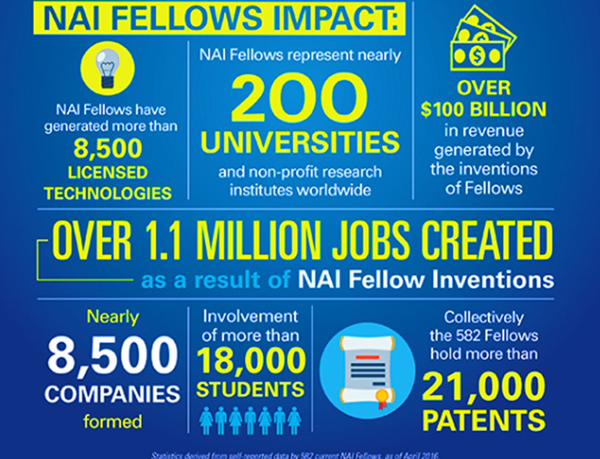
Then USF did something truly radical almost five years ago: We worked on changing our tenure and promotion policy to give credit to faculty who have patented and commercialized new inventions.
And we began a national conversation on changing the academic culture to recognize faculty patents and commercialization activity toward merit and promotion. At one NAI conference, we posed the question: “Would Thomas Edison Receive Tenure?
Well, a 2012 survey found that only 25 of the top 200 national research universities considered patents and commercialization activities in tenure and promotion decisions. The answer to that question would be a “yes” only if Edison were lucky enough to work at a select group of American universities.
The paper resulting from that panel discussion was published in the Proceedings of the National Academy of Sciences and, today, this important initiative continues to gain national attention.
Several organizations and university leaders are recommending and reporting on best practices for university intellectual property management, including such groups as the Association for Public and Land-grant Universities and the Association of American Universities.
This movement is changing the culture, and every time I travel the country to talk about academic invention and innovation, I sense a rising tide of excitement about what the future holds.
***
One of the first scientific organizations I joined, when I was a young man, was Sigma Xi. Standing here today, it’s a special memory of those years when I decided I wanted a career in scientific research and could join one of the oldest and largest scientific organizations in the world.
It’s wonderful to see so many colleagues at this conference … including students who are taking that great leap into a career that isn’t always easy and doesn’t always get the recognition it deserves … but has never been more important in the service to humankind.
I sense a hunger for breakthroughs that will give the world better options than it has now. We need better medicines to fight diseases … we need better technologies to harness the power of cyberspace … we need to apply all the tools we’ve created … not to widen the gap between people … but to create more sustainable, and more equitable, communities.
We need to be—as Dr. McGovern so notably identified—humanists.
The biggest lessons I’ve learned in this career aren’t the discoveries in the lab or the new technologies I’ve patented. It’s that my experience as a person—those desperate hours, the frustration of not having better options, and the pain of feeling helpless as a loved one struggles—is really everybody’s life story.
I was the fortunate one, I could go into my lab and look for answers, solve problems and discover better ways of doing things. And I could be a voice for other scientists, innovators and inventors, and bring them together to support and empower each other.
Together, we could leverage both individual influence and institutional strength for the greater good.
Some of you might think these are dark days for science and innovation—research funding is struggling and we live in a political climate where, at times, people prefer to construct their own facts.
But we can’t retreat into our labs until it is safe to come out. We have to push forward. We have to support each other and advocate for each other.
The discovery of new scientific facts, or the invention of new technology, or the application of existing research in new and exciting ways, is the external mission. But to have a truly successful career in the sciences, you must also have that internal journey—one to discover who you are, and why your life has meaning.
Every scientist has a story. I hope, as you pursue your passion to discover, innovate and invent, that your journey is one that, not only brings you external rewards, but fulfills who you are inside … and the meaningful role you can play in our larger society.
Thank you—for this wonderful honor, and for being truly great colleagues!
Photo captions
1st photo: Paul R. Sanberg.
2nd photo: The Sigma Xi John P. McGovern Science and Society Award's medal.
3rd photo: Sigma Xi President Tee Guidotti, on left, and Annual Meeting Planning Committee Member Hayat Caidi present Paul Sanberg with his John P. McGovern Science and Society Award certificate.
4th photo: Sanberg with his father, Bernard Sanberg, who suffered a stroke.
5th photo: An infographic on the impact of National Academy of Inventors Fellows, based on self-reported data by 582 current NAI Fellows, as of April 2016.